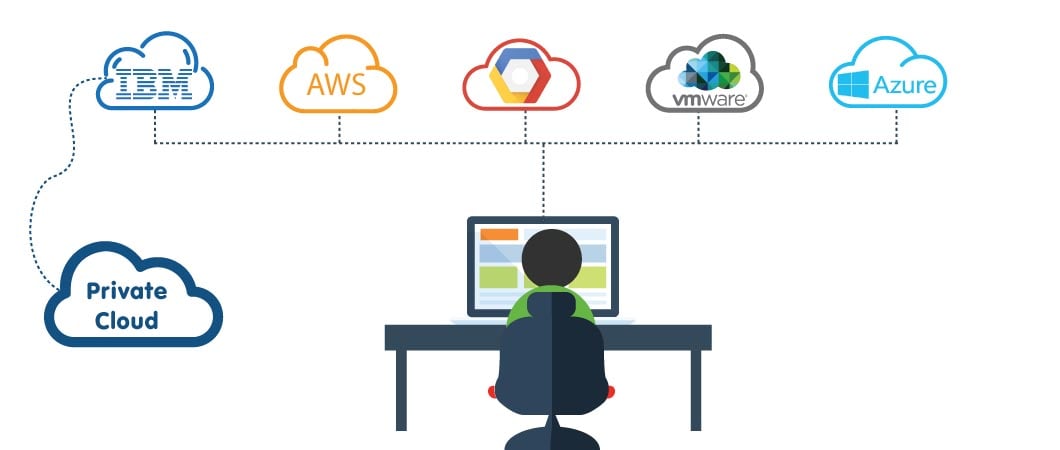The Cloud has cemented its place firmly in the enterprise. Many organizations are leveraging the cloud to deploy their workloads and applications and with the evolution of the cloud, enterprises are gradually moving away from employing a single cloud to taking a mix and match approach in choosing their cloud platforms and vendors. This has led to the growth of the multi-cloud where enterprises have the opportunity to choose the most suitable options for cloud services from different cloud providers. A survey conducted by Dimensional Research discovered that more than 77% of organizations are planning on deploying a multi-cloud architecture to gain more flexibility with their cloud solutions.
What is a Multi-Cloud Strategy?
Some big cloud outages made the news in 2016 such as that with Microsoft Office 365 in January and February and the AWS outage in Sydney Australia in June. Occurrences like this drove the realization that even a couple of hours of downtime could critically impact business operations. CIO’s and CTO’s across the globe started relooking at their cloud strategies and evaluating the risks of having only one provider across the entire cloud environment. No one wanted to have all their technology eggs in one basket. Looking at a multi-cloud strategy gave organizations the ability to protect themselves against downtime and data loss that can be caused due to a hardware, network, storage or software breakdown in a cloud environment. The additional benefit of adopting a multi-cloud strategy is that it allows organizations avoid vendor lock-ins, create more interoperability and thus improves IT performance.
A multi-cloud strategy essentially is the concurrent use of two or more cloud services. Given that with the greater digitization of the enterprise organizational requirements are becoming more complex, a multi-cloud strategy gives organizations the flexibility to make their cloud choice according to their requirements since not all cloud environments and platforms are created equal. JP Morgan had released a report titled “CIO Survey Foreshadows Changing of the Guard,” which revealed that by 2020 almost 41% of the enterprise workloads and application portfolios will be run in the cloud. IDC also reports that “86% of enterprises predict that they need a multi-cloud strategy to support their business goals in the next two years”. Clearly, thanks to the Cloud, IT is about to witness even greater disruption and organizations are looking at long term strategies to be successful in the multi-cloud environment.
When embarking on a multi-cloud journey, organizations need to make some careful considerations.
Things to Consider When Moving to a Multi-Cloud Environment
Here are some of the important considerations while moving to a multi-cloud environment:
Understand Cloud Provider Differences
Each cloud computing provider provides different core computing functionalities. For example, the instance types provided by AWS, Google and Azure are not the same and that the security measures of Azure and AWS also differ. It is, therefore, essential to recognize the difference in the cloud offerings and choose one according to your application design and architecture
Develop Readiness
Organizations have to develop readiness for a multi-cloud strategy by first building a consistent cloud foundation knowledge and then also adding technical skills for each of the cloud providers in use. This will prove critical in ensuring that the cloud-based applications can be built and used easily by all invested stakeholders.
Data Residency and Locality
You will have to clearly understand data residency and data locality demands to reduce latencies.
Security and Governance
Mature security and governance postures to navigate the security and compliance challenge will be called for. It thus becomes essential to have a common set of security policies that are implemented across the multi-cloud environment. This will have to contain rules for identity management, vulnerability assessment, intrusion detection, authentication demands etc.
API Lifecycle Management
Another consideration is the need for strong API lifecycle management policies across the public, private, and traditional applications to create, run and manage all actions in a single offering. This includes having flexible deployment options that can be managed from a single panel.
Continuous Integration and Deployment
You may have to link operations such as building, testing, and deployment, to create a continuous integration and continuous deployment pipeline and create a customized toolchains for greater efficiency and better management
Minimum Viable Cloud Architecture
As a baseline, you may have to develop a Minimum Viable Cloud architecture to define the technical and functional requirements and implementations to develop consistent capabilities in multi-cloud deployments.
Cost-Service Balance
On the business side, you will be called upon to balance cost and service availability by identifying spending patterns and service requirements.
Minimize Complexity
A key consideration is to minimize complexity by leveraging standard technology stacks, microservices, and establishing set communication pathways between applications.
Third-Party Tools Evaluation
Given the added complexity, it may become necessary to identify third party tools to manage capabilities across vendors and governance and management features that may be inconsistent across the different cloud platforms. Evaluating such tools to ensure that they are cost-effective, have strong capabilities and add value to the organization are a must.
Backup and Recovery Plan
A strong backup and recovery plan is essential. You must have a strong storage strategy for greater resiliency for better disaster management.
Clearly, the benefits of having a multi-cloud approach are many. These include more autonomy in application deployment, more flexibility, which allows you to keep applications both on premise and in one or more clouds, and extended capabilities to match the needs of specific deployments amongst others. At the same time, a multi-cloud strategy adds complexity in the form of different services, technologies, interfaces etc. It also brings into focus the question of interoperability (or the lack of it) and added management overheads and the need for a higher level of expertise across a diverse range of subjects, investments in VPN connections and monitoring etc. However, discussing the challenges of a multi-cloud strategy makes for another blog for another day – stay tuned to this blog for more on that.
FAQ
Why do organizations opt for a multicloud approach?
Organizations choose a multicloud strategy for several reasons, including redundancy, avoiding vendor lock-in, optimizing costs, and leveraging specialized services.
What are the benefits of a multicloud strategy?
Multicloud strategies offer benefits such as increased resilience, flexibility, scalability, and the ability to choose the best-in-class services from different providers.
Does a multicloud strategy increase complexity?
While managing multiple cloud providers can introduce complexity, organizations often find that the benefits outweigh the challenges, especially with proper planning and management tools.
Can multicloud strategy improve performance?
Yes, multicloud strategies can enhance performance by allowing organizations to deploy workloads closer to end-users, leverage specialized services, and optimize resource allocation based on workload requirements.
Does multicloud strategy impact security?
Multicloud strategies can enhance security by providing redundancy and the ability to implement diverse security measures across different cloud environments, although managing security across multiple platforms requires careful planning and implementation.
What challenges do organizations face when implementing a multicloud strategy?
Challenges include managing complexity, ensuring consistent governance and compliance, integrating different cloud services, data migration, and interoperability between platforms.
Is multicloud strategy suitable for all organizations?
Multicloud strategy may not be suitable for all organizations, as it requires additional resources for management and governance. Small organizations with simpler IT needs may find single-cloud solutions more practical.



